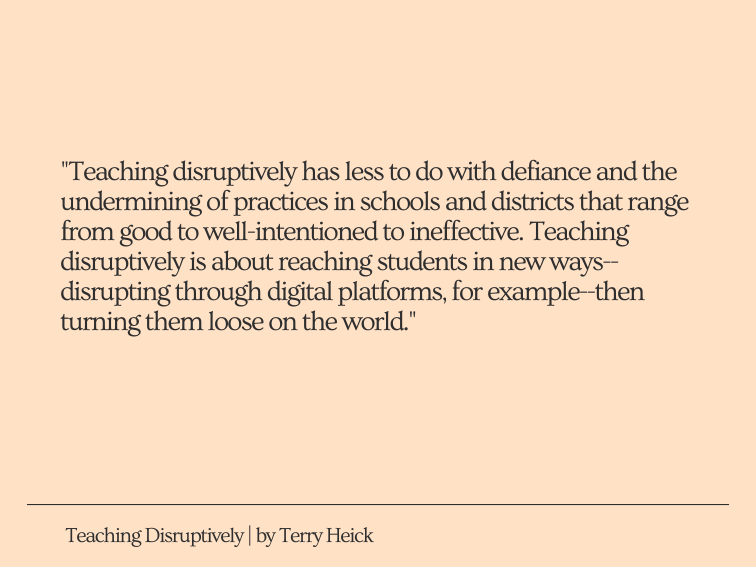
Teaching Disruptively
by Terry Heick
Disruption has been a key theme of the information age.
Disruption found legs in the 1990s under the careful study of Harvard professor Clayton Christensen. Christensen studied macro business trends over decades and saw the small, lithe business able to do things that large, cumbersome corporations could not.
This was decades ago, though—a lifetime before the current age of information and digital ooze that billions of people access daily. If what Christensen saw then was disruption, today’s version has to be hyperdisruption, buoying start-ups to comparatively instant success.
And ironically becoming giants themselves.
The life cycle here, in both disruption or hyperdisruption, is like everything else—accelerated and blurred through that acceleration, to the point where those that control the information and its access—like Google and Apple—are both disrupting (e.g., cable television) and mitigating disruption (e.g., by purchasing patents and potentially competitive startups in a frenzy). So the disruptors disrupt, then try to stall future disruption.
Gimme a minute. This will all (sort of) make sense in a few sentences.
To clarify, disruption is about, among other things, permanently unsettling existing power sets and structures for immediate redistribution. Shaking things up to the point where it all breaks.
Much like an outspoken student can disrupt a class, a disruptive teacher too seemingly has a negative connotation, but it doesn’t have to be that way–ill-tempered, outright rebellion. Some examples?
The teacher that asks Why? at staff meetings. A lot.
The teacher who refuses to ‘teach to the test.’
Robin Williams standing on his desk recounting Whitman.
And while this is all admirable and, in spots, necessary, it all misses the point of disruption: to bring about lasting change by empowering future disruptors.
A disruptive teacher can encourage (radical?) change in communities, connect students with mentors for purposes other than pure academic proficiency, and (playfully?) sabotage practices and policies in a school or district.
And the latter is the kind of stuff that, while very noble, will get you fired.
But teaching disruptively is different. Teaching disruptively has less to do with defiance and the undermining of practices in schools and districts that range from good to well-intentioned to mediocre to downright ineffective. Teaching disruptively is about reaching students in new ways–disrupting through digital platforms, for example–then turning them loose on the world.
The scale of disruption in this kind of teaching is different. Disruptive teaching makes ripples that don’t begin in your classroom but in the applied knowledge and innovation of your students.
Through project-based learning that doesn’t just ‘Raise money to fight hunger,’ but seeks to understand hunger and act against it in local communities.
Through inquiry-based learning that doesn’t just encourage students to ‘discover’ some preselected poet you had in mind, but find their own reasons for reading poetry—then finding their own poets.
And perhaps most of all, by creating self-directed learners that can ask the right question at the right time within the right community to affect the kind of change that lasts.
Much like Christensen described.
Teaching disruptively, then, has nothing to do with you. You’ll know it when you’ve found it because it won’t suggest ‘disruption’ at all.
Instead, you’ll see the rising of a kind of slow ash—of new ideas that aren’t always packaged how you asked, and don’t always do what you want them to do.
They instead find their own updrafts, moving up and arcing towards something wonderful that you can’t see because it wasn’t your idea.
